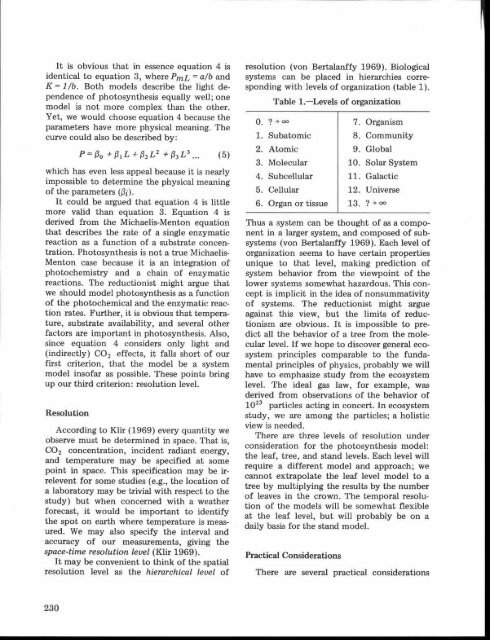PE EIE[R-Rg RESEARCH ON - HJ Andrews Experimental Forest
PE EIE[R-Rg RESEARCH ON - HJ Andrews Experimental Forest
PE EIE[R-Rg RESEARCH ON - HJ Andrews Experimental Forest
You also want an ePaper? Increase the reach of your titles
YUMPU automatically turns print PDFs into web optimized ePapers that Google loves.
It is obvious that in essence equation 4 i s<br />
identical to equation 3, where PmL = a/b an d<br />
K = 1/b . Both models describe the light dependence<br />
of photosynthesis equally well ; on e<br />
model is not more complex than the other .<br />
Yet, we would choose equation 4 because th e<br />
parameters have more physical meaning . Th e<br />
curve could also be described by :<br />
P=00 + a 1L+ 32 L 2 + 03 L3 . . . (5)<br />
which has even less appeal because it is nearl y<br />
impossible to determine the physical meanin g<br />
of the parameters ((3 i).<br />
It could be argued that equation 4 is littl e<br />
more valid than equation 3. Equation 4 is<br />
derived from the Michaelis-Menton equatio n<br />
that describes the rate of a single enzymati c<br />
reaction as a function of a substrate concentration<br />
. Photosynthesis is not a true Michaelis-<br />
Menton case because it is an integration o f<br />
photochemistry and a chain of enzymati c<br />
reactions . The reductionist might argue that<br />
we should model photosynthesis as a functio n<br />
of the photochemical and the enzymatic reaction<br />
rates . Further, it is obvious that temperature,<br />
substrate availability, and several othe r<br />
factors are important in photosynthesis. Also ,<br />
since equation 4 considers only light an d<br />
(indirectly) CO 2 effects, it falls short of ou r<br />
first criterion, that the model be a system<br />
model insofar as possible. These points brin g<br />
up our third criterion : resolution level .<br />
Resolution<br />
According to Klir (1969) every quantity w e<br />
observe must be determined in space . That is ,<br />
CO 2 concentration, incident radiant energy ,<br />
and temperature may be specified at som e<br />
point in space . This specification may be irrelevent<br />
for some studies (e .g., the location of<br />
a laboratory may be trivial with respect to th e<br />
study) but when concerned with a weathe r<br />
forecast, it would be important to identif y<br />
the spot on earth where temperature is measured.<br />
We may also specify the interval and<br />
accuracy of our measurements, giving the<br />
space-time resolution level (Klir 1969) .<br />
It may be convenient to think of the spatial<br />
resolution level as the hierarchical level of<br />
resolution (von Bertalanffy 1969) . Biological<br />
systems can be placed in hierarchies corresponding<br />
with levels of organization (table 1) .<br />
0 . ?mo<br />
Table 1 .-Levels of organization<br />
1. Subatomi c<br />
2. Atomi c<br />
3. Molecular<br />
4. Subcellular<br />
5. Cellular<br />
6. Organ or tissue<br />
Thus a system can be thought of as a component<br />
in a larger system, and composed of sub -<br />
systems (von Bertalanffy 1969) . Each level of<br />
organization seems to have certain properties<br />
unique to that level, making prediction o f<br />
system behavior from the viewpoint of th e<br />
lower systems somewhat hazardous . This concept<br />
is implicit in the idea of nonsummativit y<br />
of systems. The reductionist might argu e<br />
against this view, but the limits of reductionism<br />
are obvious . It is impossible to predict<br />
all the behavior of a tree from the molecular<br />
level . If we hope to discover general ecosystem<br />
principles comparable to the fundamental<br />
principles of physics, probably we wil l<br />
have to emphasize study from the ecosyste m<br />
level. The ideal gas law, for example, was<br />
derived from observations of the behavior o f<br />
10 23 particles acting in concert. In ecosyste m<br />
study, we are among the particles; a holistic<br />
view is needed .<br />
There are three levels of resolution under<br />
consideration for the photosynthesis model :<br />
the leaf, tree, and stand levels . Each level will<br />
require a different model and approach ; we<br />
cannot extrapolate the leaf level model to a<br />
tree by multiplying the results by the numbe r<br />
of leaves in the crown . The temporal resolution<br />
of the models will be somewhat flexibl e<br />
at the leaf level, but will probably be on a<br />
daily basis for the stand model .<br />
Practical Considerations<br />
7. Organism<br />
8. Community<br />
9. Global<br />
10. Solar Syste m<br />
11. Galactic<br />
12. Universe<br />
13. ? o<br />
There are several practical consideration s<br />
230








